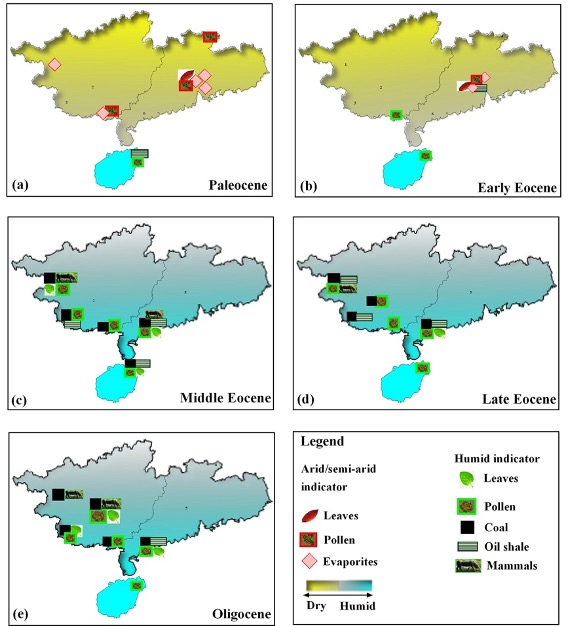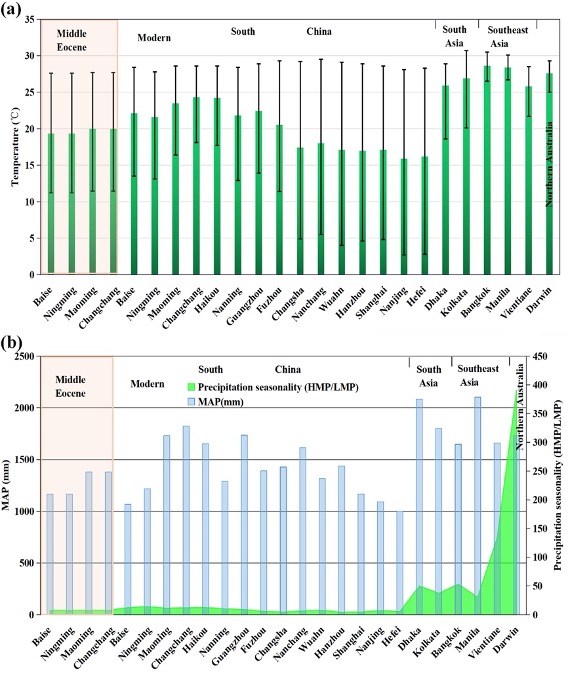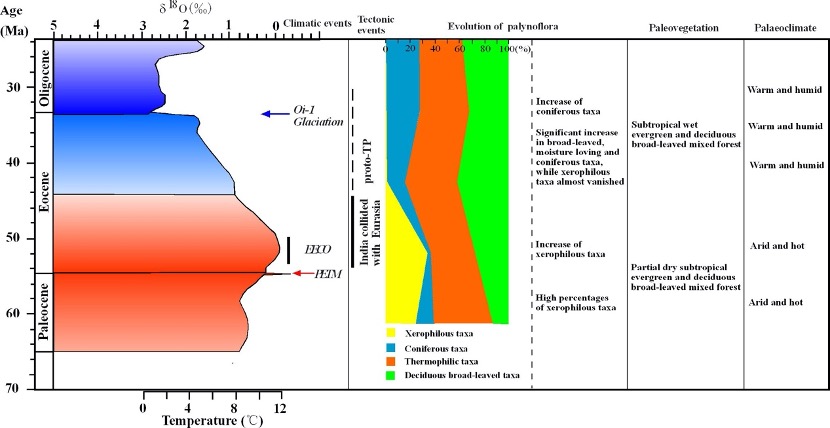The modern environment of southern China is dominated by a humid monsoon climate, and presents a striking contrast to the widespread deserts found at similar latitudes elsewhere. The formation of a monsoon climate marks a major environmental shift in southern China during the Cenozoic; however, the origin and possible driving mechanism of the climate transition remain unclear. A detailed comparison of Paleogene palynological records and an investigation of the temporal evolution of palynoflora during the Paleogene, especially the Eocene, would provide helpful insights into the evolution of climate patterns and the initiation of the monsoon in southern China.
In this paper, they concentrate on the Paleogene palynological records from seven basins (Fig. 1) throughout southern China. The Paleogene palynoflora reveals two completely different vegetation and climate patterns: the Paleocene to early Eocene was characterized by a relatively high abundance of xerophilous Ephedripites and drought-resistant Pterisisporites, suggesting an arid/semi-arid climate; while the middle Eocene to Oligocene was composed of subtropical wet evergreen and deciduous broad-leaved mixed forest characterized by a significant increase in broad-leaved, coniferous taxa, and the almost complete disappearance of xerophilous taxa, together indicating the emergence of a warm-humid climate at this time.
They summarize the evolution of climate patterns in southern China during the Paleogene using paleoenvironmental maps for five different time intervals, based on palynological records and other geological indicators, and reveal that the major environmental transition occurred roughly around the middle Eocene (Fig. 2); this transition may mark the establishment of the monsoon climate. Furthermore, the middle Eocene climatic parameters obtained by the Coexistence Approach (CA) were compared with those of modern sites under individual climate regimes; the reconstructed climatic parameters were most similar to those of the modern EAM climate in South China, while being distinct from those of modern Indian monsoon or Inter-Tropical Convergence Zone (ITCZ) monsoon (Fig. 3). These results further support the previous view that an EAM, similar to that of the present, has prevailed in southern China since as early as the middle Eocene.
The evolution of the Paleogene palynoflora in southern China is largely consistent with global climate change. They infer that the enhancement of the East Asian winter monsoon during the middle Eocene was closely related to long–term global cooling, while the intensified East Asian summer monsoon was primarily caused by the northward drift of the Indian Subcontinent and the uplift of the Tibetan Plateau (Fig. 4).
This work has recently been published in Review of Palaeobotany and Palynology, entitled “A major environmental shift by the middle Eocene in southern China: Evidence from palynological records”. The authors include Dr. Yulong Xie, Prof. Fuli Wu and Xiaomin Fang (from Institute of Tibetan Plateau Research, Chinese Academy of Sciences). This work is supported by the Strategic Priority Research Program of Chinese Academy of Sciences (XDA20070201), the Second Tibetan Plateau Scientific Expedition and Research (2019QZKK0707), CAS “Light of West China” Program, Basic Science Center for Tibetan Plateau Earth System (CTPES,No. 41988101-01) and the National Natural Science Foundation of China (41620104002).

Fig. 1. Map showing the geographic location of southern China and the position of the seven basin study sites.

Fig. 2. Paleogene environmental patterns in southern China. (a) Paleocene; (b) Early Eocene; (c) Middle Eocene; (d) Late Eocene; and (e) Oligocene.

Fig. 3. (a) Comparison between estimated temperature regimes in the middle Eocene (pink) at four study sites and modern sites in different monsoon areas. (b) Comparison between estimated precipitation seasonality and MAP in the middle Eocene (pink) at four study sites and modern sites in different monsoon areas.

Fig. 4. Comparison of Paleogene palynological records of southern China, with global climate change expressed by deep-sea δ18O records (modified from Zachos et al., 2001) and tectonic events (Wang et al., 2008, 2014; Molnar and Stock, 2009; Copley et al., 2010).


